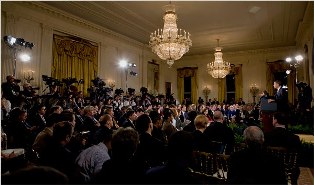President Obama Announces Girls Education Program With The Peace Corps

East Room
Thanks to Marnie Mueller (Ecuador 1963-65) for the ‘Heads Up’ news on this new program for girls’ education that the President and the First Lady, along with the Peace Corps Director, Carrie Hessler-Radelet, will announce this Tuesday afternoon in the East Room of the White House. This program–Let Girls Learn–will help adolescent girls across the world receive an education.
The Let Girls Learn initiative will build on a United States Agency for International Development campaign launched last year to provide an education to the more than 60 million girls not in school. It focuses on empowerment and leadership, health and nutrition and protection against gender-based violence protection and forced marriages, among other issues.
The Peace Corps will look for ways to overcome the barriers that prevent girls from completing their educations, including the cost of a uniform, school fees, lack of textbooks, Peace Corps Director Carrie Hessler-Radelet told reporters.
The organization’s nearly 7,000 volunteers in more than 60 developing countries already work with communities through grassroots training, Hessler-Radelet said.
“Peace Corps volunteers are in a unique position to break down barriers to girls education at the community level, working hand in hand with local leaders,” Hessler-Radelet said. “They speak the local language, they understand the local culture, they can catalyze lasting community lead change by helping communities themselves identify new opportunities to increase access to education and empower girls and young women.”
The program will start with 11 countries the first year: Albania, Benin, Burkina Faso, Cambodia, Georgia, Ghana, Moldova, Mongolia, Mozambique, Togo and Uganda. More countries will be included the following year, according to a fact sheet provided by the White House.
The Obamas will officially announce the program Tuesday afternoon in the East Room of the White Hose.
Obama’s budget recommends $250 million in new and reallocated money for girls’ programs worldwide, including eduction, Mrs. Obama’s Chief of Staff Tina Tchen said.
USAID has already invested money to Let Girls Learn, part of $1 billion invested each year in education programs. The organization has helped train more than 300,000 teachers worldwide and provide more than 35 million textbooks and teaching material each year, said Susan Markham, USAID’s senior coordinator for gender equality and women’s empowerment.
Markham said the program initiative is comprised of three main pillars:” increasing access to quality education, reducing barriers and empowering adolescent girls.
“Education is one of the most critical areas of empowerment for women,” Markham said.
Gayle Smith, senior director for development and democracy for the National Security Council said improving girls education has a positive economic and stability impact and can widen the circle of potential leaders of a given country.
“Whether it is the girls kidnapped in Nigeria or whether it is the incidents of rape in Darfur there are real issues here attended to the rights and security of these young girls and young women so that’s another key focus for us throughout the initiative,” Smith told reporters.
Great! I hope that the Obamas will continue to lend their prestige to ongoing campaigns to support education for girls worldwide.
This is a very important statement from Gayle Smith of the National Security Council:
“Whether it is the girls kidnapped in Nigeria or whether it is the incidents of rape in Darfur there are real issues here attended to the rights and security of these young girls and young women so that’s another key focus for us throughout the initiative,” Smith told reporters.”
Too often, change is presented as a mere matter of changing attitudes or giving money. When the change challenges deeply held religious beliefs, and/or cultural traditions, change can be so threatening that there is dangerous retaliation. Thank you to Gayle Smith for acknowledging this.
Fascinating fact contained in this article. USAID invests over $1 billion each year in education and has helped train more than 300,000 teachers. This paints a clear picture of the guantum difference between major development and the Peace Corps contribution in the field. I repeat once more the PC is far more important for goals 2 and 3 than goal 1, it is how many hearts and minds one affects rather than how many shots one gives, mouths one feeds, young minds one teaches, or trees one saves that is the main legacy of the Corps. Unfortunately the Corps spends most of its funds and time on goal 1.
Leo;
Wish List: I would like to see Peace Corps sponsor a conference; video or real person, in which your assertion could be debated: “Resolved, Peace Corps Goals 2 and 3 are more
important that Goal I.
I would like to see RPCVs with post service experience and academic training in development, debate this issue. I would suggest that perhaps the monitor of such a debate should be
Jonathan M. Katz, author of the book,”The Big Truck That Went By-How the World Came to Save Haiti and Left Behind a Disaster”
Joanne.
Interesting idea. I am an RPCV with post service experience in development. I also have post service experience in the global economy. My basic comment on economic development is that the global economy has done far more for economic development than has government assistance programs, large and small. Witness the dramatic growth of the world’s largest have-not country into one of its main economic powers, China. That has come from the global economy, not foreign aid.